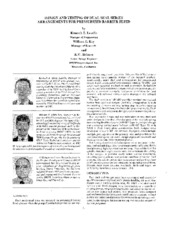| dc.contributor.other | International Pump Users Symposium (12th : 1995) | |
| dc.creator | Lavelle, Kenneth E. | |
| dc.creator | Key, William E. | |
| dc.creator | Holman, Al C. | |
| dc.date.accessioned | 2017-10-05T17:05:51Z | |
| dc.date.available | 2017-10-05T17:05:51Z | |
| dc.date.issued | 1995 | |
| dc.identifier.uri | https://hdl.handle.net/1969.1/164187 | |
| dc.description | Lecture | en |
| dc.description | pg. 31 | en |
| dc.description.abstract | Dual mechanical seals are operated on pressurized barrier fluid systems when the pump product properties do not support reliable single seal operation. This provides added protection against environmental release of the pumped product. Traditionally, many dual seal arrangements for pressurized barrier fluids consisted of two standard rotating flexible unit single seals mounted in a back to back orientation. Reliability concerns with the traditional designs include component unseating due to pressure reversal, inadequate provisions for heat removal, and collected debris causing damage to the inboard seal faces. The draft version of API 682 specifies standard pressurized barrier fluid dual seal designs (API 682 Arrangement 3) with two rotating elements and two mating rings in series (tandem arrangement). In addition, it includes design provisions for flush arrangements and component design to prevent unseating due to pressure reversals. The successful design and test validation of two dual seal series designs is described. One design is of the multiple spring type rotating flexible element (API 682 Type A), and one design uses a rotating welded metal bellows (API 682 Type B) with 0.008 in thick heavy plate construction. Both designs were developed for use in HF acid services. Design features include multiple port injection at the primary seal, and provisions for continued seal operation under a range of pressure reversals and flashing conditions of the pumped product. The testing described includes operation on propane, isobutene, and unleaded gasoline (to simulate motor alkylate) fluids in a laboratory light hydrocarbon test loop. Test validations for specific customer requirements were run to validate the ability of the designs to perform safely under various conditions, including loss of primary seal pressure and loss of barrier fluid pressure. The effects on seal face temperature and post test face condition are shown for the variations in operating conditions. Designs meet strict emission standards. Both seal types are performing in refinery services since 1991. | en |
| dc.format.medium | Electronic | en |
| dc.format.mimetype | application/pdf | |
| dc.language.iso | en | |
| dc.publisher | Turbomachinery Laboratories, Department of Mechanical Engineering, Texas A&M University | |
| dc.relation.ispartof | Proceedings of the 12th International Pump Users Symposium | en |
| dc.subject.lcsh | Pumping machinery | en |
| dc.title | Design And Testing Of Dual Seal Series Arrangements For Pressurized Barrier Fluid | en |
| dc.type.genre | Presentation | en |
| dc.type.material | Text | en |
| dc.identifier.doi | https://doi.org/10.21423/R1X11C | |


